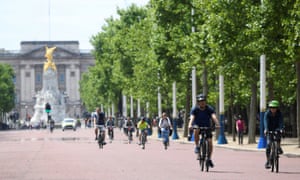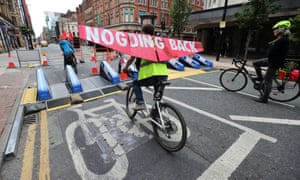Amid the confusion that followed Boris Johnson’s televised announcement easing the lockdown, Will Norman was clear about one thing – the way people move around cities would never be the same again.
“We are going to have a new normal coming out of this,” said London’s walking and cycling commissioner the morning after Johnson’s address to the nation. “Things are going to change whether we like it or not.”
The equation is clear to city leaders around the world. The coronavirus crisis means that packed public transport systems cannot run at full capacity. If people turn to private cars en masse it will lead to gridlock, economic meltdown as deliveries get snarled up and a rise in dangerous air pollution – the last thing needed in the midst of a respiratory disease pandemic.
“The only way London is going to operate in terms of our capacity on our roads and capacity on our public transport is to move wherever possible to cycling and walking,” said Norman. “It is good for our health, it is good for our mental health and it is good for the environment.”

On Friday, those sentiments began to take shape as Norman and his boss at city hall, the London mayor, Sadiq Khan, unveiled one of the most ambitious walking and cycling schemes of any city in the world, closing off large parts of central London to cars and vans to allow people to walk and cycle safely as the lockdown is eased.
It was the clearest sign yet in the UK that coronavirus has the potential to fundamentally reshape transport systems. And London is far from alone. In the past few weeks, thousands of miles of new bike lanes have been built in cities from Milan to Mexico City, huge swathes of residential streets in places from New York to Bogota are being closed to traffic, and experts say the dominance of the car is being seriously challenged for the first time in decades.
“We have no choice,” said Norman. “This is not ideological opportunism. This is a necessity.”
The potential benefits of these changes are myriad. Study after study has shown walking and cycling improve physical and mental health, build more resilient communities, drastically reduce air pollution and can go some way to decarbonise the transport system – key in the midst of an escalating climate crisis.
But the challenges are huge – not just the logistical feat of building new green transport infrastructure, but also persuading people to use it – and ensuring it does not come at an intolerable cost for the most vulnerable.
As part of the plan in London, officials have temporarily stopped free travel for children and will charge over-60s to travel at peak times as part of a deal to secure a GBP1.6bn bailout from the government.
Quick guide Seven things city leaders can do to drive a green, fair recovery from Covid-19
Show
Hide
- Remove through motor traffic from residential streets and extend pavements near shops, schools and parks to make walking safe and enjoyable for transport and exercise.
- Introduce safe access routes on foot, bike and scooter from homes to parks and green spaces and introduce automatic pedestrian lights at crossings so people do not have to push buttons and risk infection.
- Establish safe cycle routes to and from work for key workers, especially hospital staff, by closing roads and carriageways where necessary so people have a safe alternative to private cars and public transport.
- Create safe walking and cycling routes to and from schools, and close down streets around schools to motor vehicles at drop-off and pickup times.
- Use libraries, schools and sports stadiums to distribute nutritious, sustainably produced food to communities that need it most, and scale up food waste collection and treatment, including distributing household composting kits and guidance.
- Retrofit all public buildings, many of which are empty now, drastically improving energy efficiency and creating thousands of green jobs.
- Work with other cities to invest the billions tied up in city funds and pensions in climate solutions to drive green job creation and create a more resilient and sustainable economy.
Angus Satow from Labour for a Green New Deal warned the bailout would lead to a hike in fares, make travel for under-18s much harder and reduce the rights of the disabled and elderly people.
“It’s great to see parts of London going car-free. But the … demand should be for full public funding of TfL and lowering or even the abolition of fares.”
Susan Kenyon, an academic who specialises in travel and behaviour change, said it was simplistic to assume that building more cycle lanes and closing off roads to traffic would, on its own, lead to long lasting changes in behaviour.
“For 100 years governments and industry have put cars and car use at the centre of our life and policy [decisions] and it will take a huge effort to unpick that.”
Kenyon said everything from people’s work journeys to access to healthcare and education, shopping to leisure activities had been built on the assumption that people could travel long distances with ease.
“The reality of people’s everyday life is that you cannot walk or cycle to everything you need to do.”
She said policymakers would need a more root and branch approach, challenging the assumption of mobility by encouraging home working, improving broadband access and “re-localising” services.
The idea of a 15-minute city – where everything you need is on or near your doorstep – has been championed by the Paris mayor, Anne Hidalgo, to help achieve an “ecological transformation” of French capital.
In London last week, some of the challenges of achieving such changes were apparent as images circulated of Londoners crowding on to buses and tubes to return to work.
Dr Rachel Aldred, academic and transport expert at the University of Westminster, said: “You look at the people who are being told to go back to work, people who travel by public transport and don’t have many alternatives – bus commuters in particular, who are disproportionately lower income, [from ethnic minorities], women – these are people who are suffering most at the moment but also have the most to benefit in terms of creating cleaner, more equitable, more liveable cities.”
Aldred said authorities must act swiftly and that a combination of dedicated bike lanes, particularly along main roads and bus routes, a rollout of e-bikes and e-scooters, and networks of pedestrianised or semi-pedestrianised neighbourhoods could bring huge benefits not just to city centres but to more deprived neighbourhoods that had the most to gain.
“I can see a virtuous circle where if we get this right, in two years’ time, we will have more liveable neighbourhoods in our towns and cities.”
Aldred said that although cycling was often seen as a “city thing”, many of the UK’s towns and smaller urban areas were better suited to cycle networks.
“The journeys people make to the shops or work or for leisure in towns are often shorter than in cities so creating safe walking and cycling routes could transform how people move around.”
She called on the government not only to provide financial support to local authorities who might not have direct experience of setting up these alternative transport systems, but also to set up a centre of excellence to provide practical advice.
So far the government has backed an increase in active travel. New guidance was issued by the Department for Transport saying it expected councils to give more road space to cycling and walking.

Ministers also allocated GBP2bn for cycling and walking out of a previously announced GBP5bn that had been earmarked for cycling and buses. However, campaigners point out that these figures are still dwarfed by the GBP27bn road building budget.
But on the ground things are already starting to change. In Hackney in east London, councillor John Burke said work was under way to build a series of “modal filters” – closing residential streets to through traffic in the style of the successful mini-Holland scheme in nearby Walthamstow.
“This is about creating the conditions in which society can function without paving the way for second, third, fourth waves of coronavirus,” he said.
Burke is clear the programme being rolled out through experimental traffic orders – which allows the work to go ahead without lengthy public consultations – has to work for everyone.
“It is very important that we democratise these spaces so we need to see these mini-Holland type initiatives in the most deprived areas and more prosperous neighbourhoods … good stuff for everyone must be our mantra.”
Outside cities and towns, experts say a relatively small investment in buses – GBP3bn, according to Friends of the Earth – could make them free for everyone, transforming the transport options for rural areas.
Aldred said the advances in e-bikes could also have a huge impact for longer journeys in both cities and rural areas. “Suddenly journeys that were not realistic because of length for most people are now very doable,” she said.
For those who still need to make journeys by car, a relatively modest investment in charging infrastructure could see the UK follow in the footsteps of Norway, which has seen a revolution in electric car uptake in the past five years.
“For electric cars the technology is basically there – it’s a question of ensuring that those who need it have access, rather than electric cars being a minority middle-class status symbol,” said Aldred. “For short to medium-distance trips, though, many people should be able to use a bike or e-bike rather than a car or e-car, so infrastructure for bikes of all types – much cheaper, greener, and more efficient than e-cars – should be prioritised.”
For many city dwellers across the UK, that is fast becoming a more realistic option. The Scottish government has announced GBP10m to create pop-up walking and cycling routes and in Greater Manchester council leaders have unveiled plans to give more space for people walking and cycling, including the pedestrianisation of part of Deansgate, in the city centre.
Back in London, as bike lanes spring up along Euston Road and Park Lane, and some major roads are closed to cars, Norman insists the capital has entered a new, dynamic era.
“If it works, great – if not, then fail fast … this a radically different way of looking at our street space.”
And whatever emerges from the crisis, he is adamant there is no going back.
“Once people have less pollution, can hear birdsong and cycle safely on a street they want it for their neighbourhood … These are things people are beginning to appreciate and will want to keep.”
